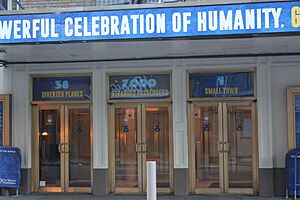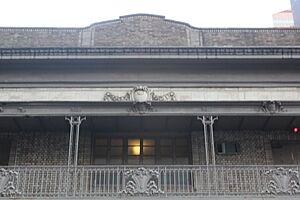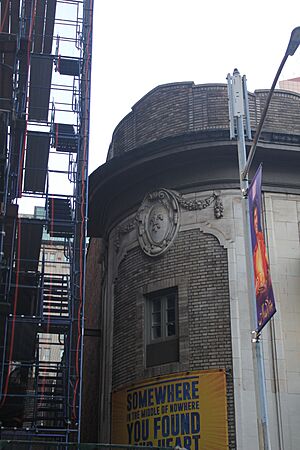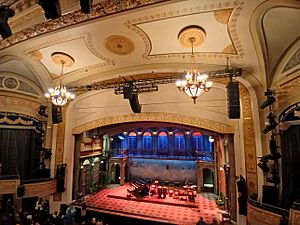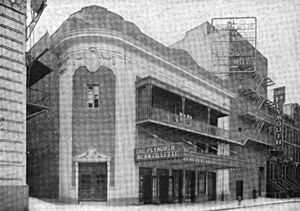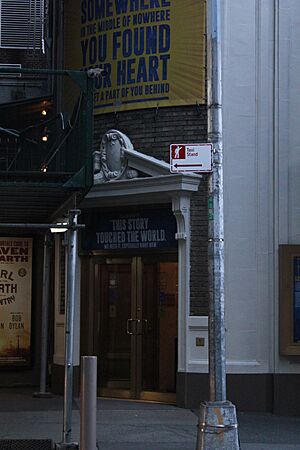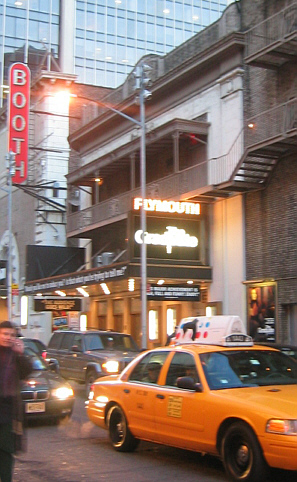Gerald Schoenfeld Theatre facts for kids
|
Plymouth Theatre
|
|
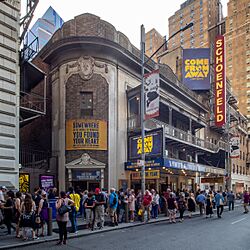
Come From Away at the Gerald Schoenfeld Theatre (2019)
|
|
| Address | 236 West 45th Street Manhattan, New York United States |
|---|---|
| Coordinates | 40°45′31″N 73°59′15″W / 40.7585°N 73.9874°W |
| Public transit | Subway: Times Square–42nd Street/Port Authority Bus Terminal |
| Owner | Schoenfeld Theatre, LLC |
| Operator | The Shubert Organization |
| Type | Broadway |
| Capacity | 1,079 |
| Production | Buena Vista Social Club |
| Construction | |
| Opened | October 10, 1917 |
| Architect | Herbert J. Krapp |
| Designated | December 15, 1987 |
| Reference no. | 1368 |
| Designated entity | Facade |
| Designated | December 15, 1987 |
| Reference no. | 1369 |
| Designated entity | Auditorium interior |
The Gerald Schoenfeld Theatre is a famous Broadway theater located at 236 West 45th Street in the Theater District of Midtown Manhattan in New York City, New York, U.S. It first opened in 1917 and was known as the Plymouth Theatre until 2004. The theater was designed by Herbert J. Krapp for the Shubert brothers, who were very important in the theater world.
Today, the Schoenfeld Theatre is named after Gerald Schoenfeld, who was the president of the Shubert Organization for a long time. This organization still runs the theater. The theater has 1,079 seats spread across two levels. Both the outside (called the facade) and the inside of the theater are protected as New York City landmarks. This means they are historically important and cannot be changed easily.
The outside of the theater looks simple but elegant. It's made of light-colored brick and terracotta. The inside of the theater is decorated in a style called Adam style, with beautiful plaster designs. There are special box seats near the stage, which is called the proscenium arch. Over the years, the theater has shown many different types of performances, including musicals, comedies, and dramas.
Contents
Where the Theater is Located
The Gerald Schoenfeld Theatre is at 236 West 45th Street in Midtown Manhattan, New York City. It's on the south side of the street, between Eighth Avenue and Seventh Avenue. This area is known as the Theater District, and it's very close to Times Square.
The theater is part of a block that has the most Broadway theaters in one place. It's next to six other theaters: the Majestic, John Golden, Bernard B. Jacobs, Booth, Shubert, and Broadhurst. This makes the area a very busy and exciting place for theater lovers.
The Shubert brothers built the Broadhurst and Schoenfeld (then Plymouth) theaters together. They also built the Shubert and Booth theaters nearby. These theaters share an alley, which was needed for construction rules back then.
How the Theater Was Designed
The Schoenfeld Theatre was designed by Herbert J. Krapp and built in 1917. It was one of Krapp's first big projects as an architect. While the outsides of the Schoenfeld and Broadhurst theaters look similar, their insides are quite different. The Shubert Organization still manages the Schoenfeld Theatre today.
The Outside Look
Krapp designed the outside of the Schoenfeld Theatre to be simple, using brick and stone. He made the corners facing Broadway curved because most people came from that direction. This simple design was common for theaters built by the Shubert family.
The outside of the Schoenfeld Theatre is split into two main parts: the stage area on the west side and the main entrance on the east side.
Main Entrance Area
The bottom part of the entrance area is made of granite. The rest is mostly architectural terracotta with light-colored bricks. There are three glass and bronze doors that lead into the lobby. A large sign, called a marquee, hangs above these doors. The corner of the building is curved and has another entrance for tickets. This entrance has a fancy top design with a shield in the middle.
On the second and third floors, there's a fire escape made of metal. It has doors and windows that open onto it. Above the third floor, there are decorative carvings, including shields and ribbons. The curved corner also has a window with an oval shield above it, decorated with flowers. A decorative ledge and a brick wall run along the top of this part of the building.
Stage House Area
The stage house is the taller part of the building, about six stories high. It's made of light-colored brick with diamond patterns. The ground floor has two metal doors. One is extra tall so that large sets for plays can be brought inside. There are also windows on the upper floors, each with a rounded top. A metal fire escape is also on this part of the building.
Inside the Theater
The inside of the Schoenfeld Theatre has a main floor (called the orchestra level), a large balcony, and special boxes on the sides. The stage is at the front, behind a decorative arch. The theater is wider than it is deep, and it's decorated with plaster designs that stick out from the walls.
The Shubert Organization says the theater has 1,079 seats. The seats are divided into 653 on the orchestra level, 392 on the balcony, and 24 in the boxes. There are also 15 spots for standing. The orchestra level is accessible for wheelchairs, but you need to use stairs to get to the balcony. Restrooms and water fountains are in the basement.
The Schoenfeld's interior is known for its beautiful Adam style decorations. These plaster designs often show classical figures playing musical instruments.
Seating Areas
At the back of the orchestra level, there's a wide walkway called a promenade. It has columns that support the balcony above. The ceiling of this walkway has decorative bands and chandeliers. Two staircases lead from here up to the balcony. The orchestra floor slopes down towards the stage, where there's a pit for musicians. The walls in the orchestra area have decorative plaster panels and doorways.
The balcony also has a promenade at the back with decorated walls. Columns with fancy tops support a decorative band that shows sphinxes and urns. The side walls of the balcony also have plaster panels and doorways. The underside of the balcony has decorative panels with lights. There's also a small area above the back of the balcony for technical equipment.
On each side of the stage, there are three special box seats on the balcony level. These boxes are decorated with leaf designs and have lights underneath. Above the boxes, there's a curved arch that supports a special part of the ceiling called a sounding board.
Other Design Features
The stage is framed by a large, curved arch called the proscenium arch. This arch is decorated with vine patterns and medallions. It's about 38 feet tall and 40 feet wide. Above the arch, the sounding board helps direct sound from the stage to the audience. It has a large central panel and circular medallions with chandeliers.
The main ceiling of the theater is mostly flat, but it curves down towards the stage. It's surrounded by decorative moldings with leaves and other designs. The center of the ceiling has a pattern of crisscrossing lines with circular medallions and chandeliers.
History of the Theater
The area around Times Square became the main place for big theater shows between 1900 and the 1930s. The Shubert brothers, who were from Syracuse, New York, became very powerful in the theater world. By 1925, they controlled a huge part of all plays and ticket sales in the U.S.
Building and Early Years
The Shubert brothers had already built the Shubert and Booth theaters in 1913. Because those were so successful, they decided to build two more theaters next door: the Broadhurst and the Plymouth (now Schoenfeld). Architect Herbert J. Krapp submitted plans for the new theater in December 1916.
A theater producer named Arthur Hopkins leased the new theater from the Shuberts in July 1917. He wanted another theater to help his business grow. Hopkins got to name the theater, and he chose "Plymouth." It was the fourth theater the Shuberts built in New York City in 1917 alone!
The Plymouth Theatre officially opened on October 10, 1917, with a comedy called A Successful Calamity. Over the next few years, it hosted many famous actors and plays, including John Barrymore in Redemption and The Jest, and Alla Nazimova in plays by Henrik Ibsen.
In the 1920s, the theater continued to have popular shows. Little Old New York ran for over 300 performances in 1920. Another big hit was the wartime play What Price Glory?, which opened in 1924 and ran for 435 performances. In 1926, Winthrop Ames brought back popular Gilbert and Sullivan operettas like Iolanthe and The Pirates of Penzance. In 1927, the play Burlesque was a huge success, running for 372 performances.
1930s and 1940s
The Plymouth Theatre continued to host many plays in the 1930s and 1940s. In 1931, Counsellor at Law with Paul Muni was a hit. Other notable plays included Dark Victory with Tallulah Bankhead in 1934, and a play based on Pride and Prejudice in 1935.
In the late 1930s, the theater had several long-running shows. Tovarich ran for almost a year starting in 1936. Susan and God with Gertrude Lawrence also ran for many months in 1937. Robert E. Sherwood's play Abe Lincoln in Illinois, which won a Pulitzer Prize, ran for a full year starting in 1938. In 1942, Thornton Wilder's The Skin of Our Teeth with Tallulah Bankhead was a big success, running for 355 performances.
In the mid-1940s, the theater hosted Lute Song in 1946, featuring Mary Martin and Yul Brynner. In 1948, Tallulah Bankhead returned in Private Lives, which ran for 248 performances.
1950s to 1970s
After Arthur Hopkins passed away in 1950, the Shubert brothers took over running the Plymouth Theatre. Happy Time opened that same year and ran for 614 performances. In 1952, the mystery play Dial M for Murder was a hit, staying for 552 performances. The Caine Mutiny Court-Martial opened in 1954 and ran for 405 performances.
In 1958, the comedy The Marriage-Go-Round with Charles Boyer and Claudette Colbert ran for two years. The musical Irma La Douce opened in 1960. In 1965, the famous Neil Simon comedy The Odd Couple premiered at the Plymouth with Walter Matthau and Art Carney, running for over a year. Simon had another hit with Plaza Suite in 1968, which ran for an amazing 1,097 performances.
The 1970s also saw many successful shows. Equus opened in 1974 and ran for two years. The musical Runaways moved to the Plymouth in 1978. Then, the popular Fats Waller musical revue Ain't Misbehavin' moved to the theater in 1979 and stayed for two years.
1980s and 1990s
In 1981, the theater hosted Piaf. Later that year, the very long (eight-hour!) play The Life and Adventures of Nicholas Nickleby was performed. In 1984, The Real Thing by Tom Stoppard was a big success, running for 566 performances.
In 1987, the outside and inside of the Plymouth Theatre were officially named New York City Landmarks. This meant they were protected because of their historical importance. Even though the theater owners tried to challenge this, the landmark status was upheld in 1992.
The theater continued to host popular plays like Burn This in 1987 and The Heidi Chronicles in 1989. In 1991, Dancing at Lughnasa ran for 421 performances. The Stephen Sondheim musical Passion opened in 1994. The last big show of the 1990s was the musical Jekyll & Hyde, which opened in 1997 and ran for 1,543 performances until 2001.
2000s to Today
In the early 2000s, the Plymouth hosted a revival of Bells Are Ringing in 2001. The play The Graduate, based on the movie, ran for almost a year starting in 2002. In 2003, the Shuberts agreed to make their theaters, including the Plymouth, more accessible for people with disabilities.
In September 2004, the Shubert Organization decided to rename the Plymouth Theatre after its president, Gerald Schoenfeld. The theater was officially renamed the Gerald Schoenfeld Theatre on May 9, 2005.
After the renaming, the musical A Chorus Line opened in October 2006 and ran for almost two years, becoming a big hit. Other shows in the late 2000s included All My Sons (2008) and A Steady Rain (2009).
In the 2010s, the Schoenfeld hosted a mix of plays and musicals, often for shorter periods. These included A Behanding in Spokane (2010), The ... with the Hat (2011), The Best Man (2012), and Orphans (2013). The theater was renovated in 2014.
In 2016, the play The Humans moved to the Schoenfeld. It closed in early 2017 to make way for the musical Come from Away, which opened in March 2017. Come From Away was a huge success and ran for four years until the theater had to close on March 12, 2020, because of the COVID-19 pandemic.
The Schoenfeld Theatre reopened on September 21, 2021, with Come From Away. This musical became the theater's longest-running show before it closed in October 2022. After that, Take Me Out moved to the theater. In March 2023, Life of Pi opened and ran for four months. In 2024, the musical The Notebook played for nine months. The musical Buena Vista Social Club opened there in March 2025.
Notable Productions
Here are some of the important shows that have played at the Gerald Schoenfeld Theatre, listed by when they first opened.
Plymouth Theatre
| Opening year | Name |
|---|---|
| 1917 | A Successful Calamity |
| 1918 | Redemption |
| 1918 | Hamlet |
| 1919 | The Jest |
| 1920 | Richard III |
| 1922 | The Old Soak |
| 1924 | What Price Glory? |
| 1926 | Iolanthe |
| 1926 | The Pirates of Penzance |
| 1927 | Burlesque |
| 1928 | Machinal |
| 1928 | Holiday |
| 1931 | Counsellor at Law |
| 1934 | Dark Victory |
| 1935 | Pride and Prejudice |
| 1937 | Susan and God |
| 1938 | Abe Lincoln in Illinois |
| 1942 | The Skin of Our Teeth |
| 1946 | Lute Song |
| 1948 | Private Lives |
| 1950 | The Happy Time |
| 1952 | Dial M for Murder |
| 1954 | The Caine Mutiny Court Martial |
| 1958 | The Marriage-Go-Round |
| 1960 | Irma la Douce |
| 1965 | The Odd Couple |
| 1968 | Plaza Suite |
| 1974 | Equus |
| 1979 | Ain't Misbehavin' |
| 1981 | The Life and Adventures of Nicholas Nickleby |
| 1984 | The Real Thing |
| 1989 | The Heidi Chronicles |
| 1991 | Dancing at Lughnasa |
| 1994 | Passion |
| 1997 | Jekyll & Hyde |
| 2002 | The Graduate |
Gerald Schoenfeld Theatre
| Opening year | Name |
|---|---|
| 2006 | A Chorus Line |
| 2008 | All My Sons |
| 2011 | The ... with the Hat |
| 2012 | The Best Man |
| 2014 | The Bridges of Madison County |
| 2014 | It's Only a Play |
| 2016 | The Humans |
| 2017 | Come from Away |
| 2022 | Take Me Out |
| 2023 | Life of Pi |
| 2024 | The Notebook |
| 2025 | Buena Vista Social Club |
Box-Office Records
The Gerald Schoenfeld Theatre has set some impressive box office records over the years.
- The play It's Only a Play earned $1,455,818 in one week in January 2015.
- The current record was set by the musical Come From Away. It earned $1,834,218 in just nine performances during the week ending December 31, 2017.
See also
- List of Broadway theaters
- List of New York City Designated Landmarks in Manhattan from 14th to 59th Streets


